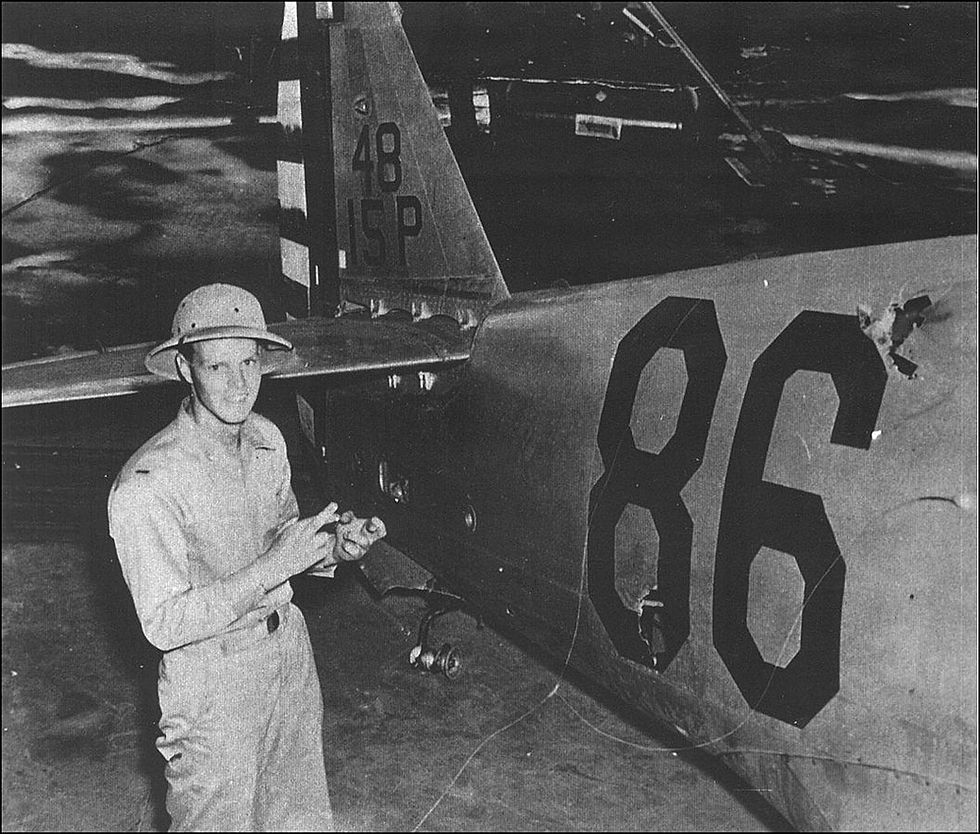This Day in History: Lt. Col. Phillip Rasmussen, hero of Pearl Harbor
- tara
- Apr 30, 2022
- 3 min read
Updated: Jul 9, 2024
On this day in 2005, Lt. Col. Phillip Rasmussen passes away. He is best known for his actions on December 7, 1941, during the Japanese attack on Pearl Harbor.
He’s since been dubbed the “Pajama Pilot.” He was one of the few fighter pilots to get a plane into the air that day. But when the Japanese attack began, he didn’t even stop long enough to put on a flight suit. Instead, he rushed out to the runway in a pair of purple pajamas.
Perhaps a small snapshot of the huge mental shift forced upon our military? Our boys woke up, at peace, but were thrown into wartime measures within a matter of seconds or minutes.

Rasmussen was then just a 23-year-old second lieutenant. He’d barely woken up and was standing in the latrines when he looked out a window: An aircraft was coming into view. “[A]n object dropped from this plane,” Rasmussen later said. “And then I saw this huge orange explosion of smoke and orange flames. And when this airplane pulled up, I saw the two meatballs, or the two round circles identifying it as a Japanese aircraft.”
Rasmussen was stunned. He ran to his room to retrieve his belt, his gun, and some shoes. When he went outside, Japanese were strafing the area.
Unfortunately, American pilots such as Rasmussen were hampered by decisions made long before December 7. Military leadership had been worried about sabotage, not a Japanese air attack. Thus, they’d left aircraft, wingtip-to-wingtip, on the flight line.
Gathering the planes together in one place made them easy to guard against sabotage. Unfortunately, it now also made them an easy target for Japanese planes flying overhead.
“I saw the airplanes were in,” Rasmussen described, “wingtip to wingtip, lined up. . . . the Japs had started to bomb and strafe the aircraft at the end of the line . . . each airplane was exploding and igniting the one next to it, because they were so close together.”
Fortunately, he spotted several Curtiss P-36A Hawk fighter planes further down, away from the other aircraft. The P-36 was a bit older, but it would have to do. Rasmussen and a few other pilots ran for the planes, quickly arming them and taking off.
They were soon in a dogfight with the enemy at Kaneohe Bay. Rasmussen was in an old, clunky plane compared to those Japanese Zeroes, but he managed to shoot one down anyway. He crippled another, then turned to see a Japanese aircraft apparently trying to ram him. He pulled away, only to be hit by enemy fire.
“[M]y airplane shuddered, and my canopy blew off,” Rasmussen later said, “and I lost control of the plane, momentarily.”
He hid in a nearby cloud while he struggled to regain control. He was also trying to figure out just how badly he was hurt. He’d taken off in pajamas, without even a helmet—and he’d been hit in the head.
“I just had a headset on and I gingerly felt—when I had got the airplane finally straightened out a little bit, straight and level, I gingerly reached up to see if, how much was left of the top of my head, and all I found was a bunch of shredded Plexiglas in my hair, and I didn’t have a scratch anywhere.”
Amazingly, Rasmussen managed to land his plane without functional brakes, rudder, or tailwheel. He even avoided a little friendly fire on the way back. Some Americans were shooting at anything in the sky, not realizing that a few American planes had managed to get airborne during the chaos.
Rasmussen later discovered 500 bullet holes in his plane.
The Japanese had taken us off guard. But the Greatest Generation was fighting back, instinctively, right from the beginning.
Enjoyed this post? More World War II
stories can be found on my website, HERE.
Primary Sources:
Daniel Brown, 7 real-life heroes you’ve never heard of from the Pearl Harbor attack 77 years ago (Business Insider; Dec. 6, 2018)
Lt. Phillip Rasmussen and His P-36A (National Museum of the United States Air Force)
Oral History Interview with Phil Rasmussen (posted on National Park Service website HERE)
Pearl Harbor's Deadly Dozen: The Story of the American Pilots that Fought Back during the Japanese Attack on Pearl Harbor (Air Classics Magazine; August 1986) (available HERE)
Pearl Harbor: The Essential Reference Guide: The Essential Reference Guide (Spencer C. Tucker ed. 2015)
Robert Dorr, Air Combat: An Oral History of Fighter Pilots (2006)
The Forgotten Battle for the Skies over Pearl Harbor (National Interest; Oct. 7, 2017)



Comments